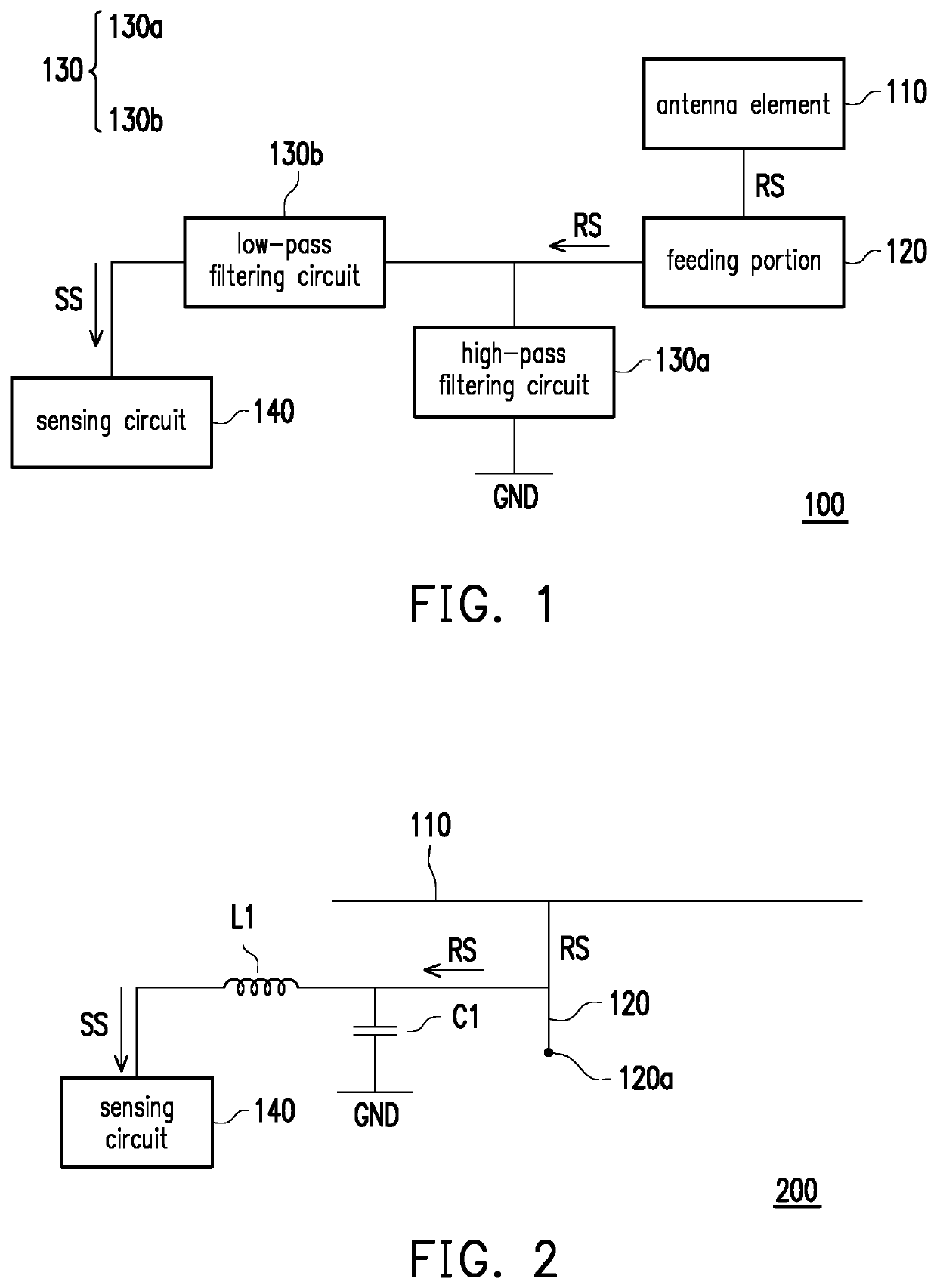Antenna device
a technology of antenna device and antenna element, which is applied in the direction of resonant antenna, substantially flat resonant element, instruments, etc., can solve the problems of increased difficulty in designing related structures, high interference between sensing element and antenna element, and difficulty in adjusting antenna characteristics, etc., to achieve the effect of reducing the volume of the antenna devi
- Summary
- Abstract
- Description
- Claims
- Application Information
AI Technical Summary
Benefits of technology
Problems solved by technology
Method used
Image
Examples
first embodiment
[0028]In an embodiment of the disclosure, the antenna element 110 is capable of simultaneously transmitting or receiving the radiation signal and sensing whether the human body approaches the antenna device 100. Thus, in a first embodiment, when the antenna element 110 is excited by the feeding portion 120 and employed for transmission, the radiation signal RS provided by the feeding portion 120 may include only the second component (e.g., the radio frequency component), and the antenna element 110 may correspondingly transmit the second component. In an embodiment, when the antenna element 110 is implemented as the PIFA, the second component may include a first sub component and a second sub component belonging to different frequency bands which are radiated respectively via different paths provided by the antenna element 110 (i.e., the PIFA), but the disclosure is not limited thereto.
[0029]In this situation, the filtering circuit 130 may receive the radiation signal RS provided by...
second embodiment
[0030]On the other hand, in a second embodiment, when the human body approaches the antenna device 100 and the antenna element 110 does not receive any other signal, the antenna element 110 may sense and correspondingly provide the radiation signal RS including only the first component (e.g., the base frequency component), and the radiation signal RS may be transmitted to the filtering circuit 130 via the feeding portion 120. In this circumstance, the low-pass filtering circuit 130b may allow only the first component (e.g., the base frequency component) of the radiation signal RS to pass through to form the sensing signal SS. In this situation, the sensing circuit 140 may determine that the human body approaches the antenna device 100 based on the sensing signal SS (which includes only the aforementioned first component). Correspondingly, the sensing circuit 140 may transmit a control signal to a related control circuit of the antenna element 110 to reduce an output power of the ant...
third embodiment
[0031]In a third embodiment, when the human body approaches the antenna device 100 while the antenna element 110 is being employed to receive another signal, the radiation signal RS provided by the antenna element 110 may include both the first component (which is, for example, the base frequency component formed by sensing the human body) and the second component (i.e., the radio frequency component), and the radiation signal RS may be transmitted to the filtering circuit 130 via the feeding portion 120. In this circumstance, the high-pass filtering circuit 130a may guide the second component of the radiation signal RS to the ground terminal GND to remove the second component from the radiation signal RS, and the low-pass filtering circuit 130b may allow only the first component of the radiation signal RS to pass through to form the sensing signal SS. In this situation, the sensing circuit 140 may determine that the human body approaches the antenna device 100 based on the sensing ...
PUM
 Login to View More
Login to View More Abstract
Description
Claims
Application Information
 Login to View More
Login to View More - R&D
- Intellectual Property
- Life Sciences
- Materials
- Tech Scout
- Unparalleled Data Quality
- Higher Quality Content
- 60% Fewer Hallucinations
Browse by: Latest US Patents, China's latest patents, Technical Efficacy Thesaurus, Application Domain, Technology Topic, Popular Technical Reports.
© 2025 PatSnap. All rights reserved.Legal|Privacy policy|Modern Slavery Act Transparency Statement|Sitemap|About US| Contact US: help@patsnap.com

